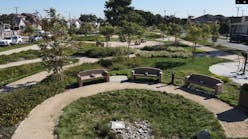Grass Pavers Help Water Park Complete the Water Cycle
Building an aquatic park in the middle of the California drought presented more issues than just the construction, costs or scheduling. A community voiced concerns with water use for recreation when their drinking, agricultural and bathing water was being severely reduced. Luckily, the designers had already initiated a water plan to address the water’s use and reuse, and returning water to the natural cycle. A grass paver fire lane was a critical portion of the plan.
Design began on Dublin, Calif.,’s aquatic center, also known as The Wave, before California had entered the severe drought. Gregor Markel, architect for DAHLIN Group, took a holistic approach to the water conservation with an automated pool filtration and backwash, automated water makeup system, automated chemistry controllers, and thermal blankets, retaining and repurposing pool backwash water for irrigation and reducing water use around the site.
Markel designed a grass paver fire lane surrounding the site that works as bioswale, catching the storm water runoff and returning it to the groundwater. The grass paver fire lane is a system by Invisible Structures Inc. called Grasspave2. The grass paver works as a grass root-protection mechanism, allowing heavy fire trucks to drive on the natural grass without crushing the roots. The paver also is porous, which allows the recycled pool irrigation water and storm water runoff from a rain storm to percolate back into the groundwater supply.
The grass fire lane surrounds the perimeter of The Wave and, in turn, is encompassed by asphalt parking, asphalt drives and concrete gutters. The runoff from rain on the impermeable surfaces is sloped toward the grass paver and other bioswale areas.







